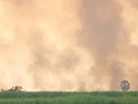Record Greenhouse Gas Emissions Cause ‘Alarm Bells’

Relentless use of fossil fuels, unsustainable development and forest fires, exacerbated by global warming, are waging war on the planet.
The 20th World Meteorological Organisation (WMO) annual Greenhouse Gas Bulletin reveals that in the last 20 years, concentrations of CO₂ have risen by a stark 11.4%.
These levels of carbon dioxide have not been seen on Earth for 3-5 million years, a period when the temperature was 2-3°C warmer and sea levels were 10-20 metres higher.
The Greenhouse Gas Bulletin is issued each year ahead of the United Nations Conference of the Parties (COP) to guide global leaders’ decision-making.
The 2024 report sets a comprehensive agenda for the upcoming discussions at COP29 in Azerbaijan.
“Another year. Another record. This should set alarm bells ringing among decision makers,” says Celeste Saulo, Secretary General of the WMO.
“We are clearly off track to meet the Paris Agreement goal of limiting global warming to well below 2°C and aiming for 1.5°C above pre-industrial levels.
“These are more than just statistics. Every part per million and every fraction of a degree temperature increase has a real impact on our lives and our planet.
About the WMO Greenhouse Gas Bulletin
The WMO is a United Nations body focusing on weather, climate and water resources.
Unlike many reports that focus on emissions, the WMO's bulletin assesses the atmospheric concentrations of long lasting greenhouse gases — namely CO₂, methane and nitrous oxide.
The report has been published annually since 2004 with the latest analysis of observations from the Global Atmosphere Watch (GAW) programme.
The October 2024 report details data from 2023 and shows the concentration of CO₂ reached 420 parts per million, methane at 1934 parts per billion and nitrous oxide at 336.9 parts per billion.
These numbers signify 151%, 265% and 125% of pre-industrial levels respectively.
The warming influence of these gases on the climate has increased by 51.5% since 1990, driven heavily by carbon dioxide, which accounts for about 81% of this increase.
Ko Barrett, Deputy Secretary General of the WMO, says: “The Bulletin warns that we face a potential vicious cycle.
“Natural climate variability plays a big role in the carbon cycle. But in the near future, climate change itself could cause ecosystems to become larger sources of greenhouse gases.
“Wildfires could release more carbon emissions into the atmosphere, whilst the warmer ocean might absorb less CO₂.
“Consequently, more CO₂ could stay in the atmosphere to accelerate global warming. These climate feedbacks are critical concerns to human society.”
In August 2024, the WMO released a report indicating that oceans have absorbed more than 90% of excess heat from greenhouse gases, leading to changes that may be irreversible for centuries.
António Guterres, Secretary General of the United Nations, described it as “an SOS on sea level rise”.
What needs to happen to manage global warming?
According to research by NASA, once CO₂ enters the atmosphere, it can remain there for up to 1,000 years.
Methane, although more potent, remains in the atmosphere for about 12 years until it's neutralised by natural processes.
Nitrous oxide can last approximately 110 years before it's decomposed in the stratosphere.
If natural processes can't keep up with the pace of emissions, technologies like carbon capture and storage could play a critical role in mitigating rising levels.
Direct air capture (DAC) could potentially remove historical emissions from the atmosphere, ready to be stored away.
Captured carbon can also be repurposed, such as in carbon-based building materials or even putting the fizz in drinks.
Even with these technologies, the reality remains: the climate crisis is here and its effects will persist, making adaptive strategies essential.
Google’s wildfire tracking and Liebherr Group's innovative parasols that can cool their surroundings by up to 8°C, are technologies already in action.
Transitioning away from fossil fuels to renewable energy sources like solar and green hydrogen is essential for curtailing future emissions and avoiding new record highs of greenhouse gases.
Receive the next edition of ClimateTech Digital by signing up for its newsletter.
As part of this portfolio, make sure you check out Sustainability Magazine and Energy Digital and also sign up to our global conference series - Sustainability LIVE.
ClimateTech Digital is a BizClik brand

